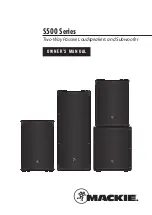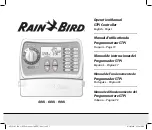
Self Regulating Heating Cable
© BriskHeat
®
Corporation. All rights reserved.
27
START-UP
Heat-up Time
Heat-up capacity (the ability to heat the pipe and it’s contents rapidly) is not normally designed into the system. Cold start-ups should
allow adequate time for the pipe to come up to temperature.
Diversity Factor
If the electrical supply capability is limited, then a diversity factor may be used in a cold start situation (trying to start the entire system up
in very cold weather). This is accomplished by staggering the initial turn on of the heating cable circuits to allow the inrush currents to
occur in a sequential fashion rather than all at once.
OPERATION & MAINTENANCE
System Design, Installation & Documentation
The heating cable system must be properly designed, installed and documented. This documentation should at least include line lists and
location identification documentation. As built installation drawings provided the optimum maintenance tool. Test records should also be
considered as part of the system documentation requirements.
See Figure 20 & 21.
Preventive Maintenance
A preventive maintenance program is needed which will encompass both visual and electrical checks of the system. These should be
done not only before initial operation of the system, but also on a scheduled basis. The checks should also be done after any
maintenance has been performed.
Visual Inspections
Thermal insulation - check weatherproofing for damage, missing seals, cracks or gaps in caulking and mastic coatings, damaged or
missing lagging. When damage does exist, the insulation will need to be repaired or replaced, and then resealed. WET INSULATION
HAS POOR INSULATING PROPERTIES, THEREFORE THE INSULATION MUST BE KEPT DRY. If insulation has been damaged,
check the heating cable for damage - replace the damaged section.
Inspect junction boxes, connection boxes and thermostats for corrosion, moisture or foreign matter.
Tightness of electrical connections, proper electrical insulation of heating cable wires, adequacy of moisture seal on electrical
connections and that a minimum of one (1) inch of electrically insulated heater extends above the grounding connection. No strands
of the ground braid should extend above this connection.
Check all thermostats or sensor capillary leads to verify they are tied back and shielded from physical damage.
Verify all enclosure, connection box, etc. covers are properly closed and that the thermostat is switching off and on by measuring
current flow in the circuit when the unit switches on. Reset the knob to the proper temperature after completion of the test.
Frequency
Inspections should be made prior to the start of the freeze season on freeze protection systems. Process maintenance systems should
be checked on a frequent base, at least twice a year.
Personnel Training
Qualified maintenance personnel must be used to maintain the system. It is recommended that periodic training programs be utilized to
assist in keeping maintenance personnel up to date on equipment and procedures.
Maintenance
The heating cables will not require any maintenance. Mechanical temperature controls should be sprayed with a moisture repellent/
corrosion inhibitor once a year on all metal parts.
Piping Repairs
Disconnect the electrical connection for the heating cable and protect it from mechanical or thermal damage during the repair. Check the
heating cable installation after the repairs per established procedures. Replace and water seal the thermal insulation system.
Self Regulating Heating Cable
© BriskHeat
®
Corporation. All rights reserved.
28
DAMAGED PRODUCTS
Do not attempt to repair a damaged heating cable - replace the entire section. Fault currents will often destroy the bus wire / core ma-
terial interface between the damaged portion and the voltage supply end of the circuit.
Replace the damaged heating cable immediately. Moisture migration into the good section of the heating cable may cause electrical
shorting in that cable after repair of the damaged section.
Any product exposed to fire or flame should be removed from service immediately and replaced. Further fire damage could result if
energized.
TROUBLESHOOTING GUIDE
PROBABLE CAUSE
CORRECTION
A. Circuit Breaker
Trips
(Standard)
1. Circuit breaker undersized
1, 2, 3. Re-establish what the current loads are going to be
and resize the breakers.*
2. Circuit oversized
3. Start-up at too low temp.
4. Defective circuit breaker
4. Replace circuit breaker.
5. Connection and/or splices may be
shorting out.
5, 6. Locate and repair incorrect connections, splices, or
damaged sections of heating cable.
** Megger per installation instructions.
6. Physical damage to the heating
cable may be causing a short.
7. Wires connected at end seal.
7. Disconnect wires and perform a current check for
possible other damage.
B. Circuit Breaker
Trips (Ground
Leakage Type)
1. All of section A.
1. All of section A.
2. Excessive moisture in connection
boxes or splices.
2. Dry out and re-seal connections and splices. Megger
per Installation Instructions (20 megohms min.) Work
on connections outside the thermal insulation first,
going to the below insulation connections and seals
after the others have been eliminated.
3. Nick or cut in heater or power feed
wire with moisture present.
3. Locate and repair or replace damaged heating cable
or power wire.
**
SYMPTOMS
* Check to see if existing power wire sizing is compatible with larger sized breakers.
** To locate shorting problems, follow these steps:
1. Visually inspect the power connections and splices that are outside of the thermal insulation for proper installation.
2. Check around the valves, pumps, and any area where there may have been maintenance work done, for visual indications of
damage.
3. Look for crushed or damaged insulation lagging along the pipe.
4. Inspect heating cable splices under the thermal insulation.
5. If you have not located the problem by now, you will have to isolate one section of the heating cable at a time until you
determine the general area of damage. First, isolate by disconnecting any tees or splices then remove insulation from that area
until the specific damage is found. For long runs of cable, it may be necessary to cut the cable in half to isolate the shorted
section.















































